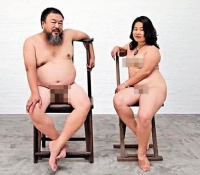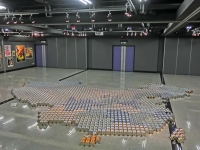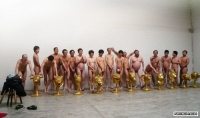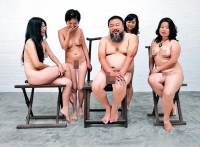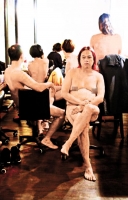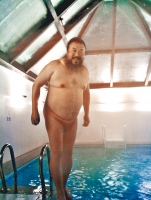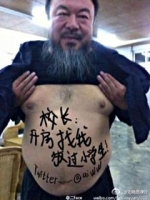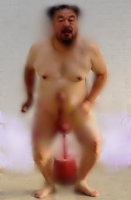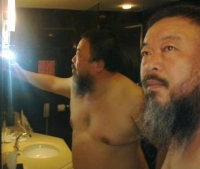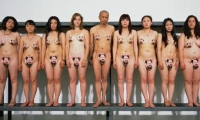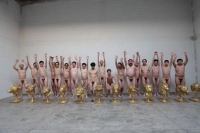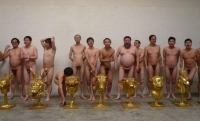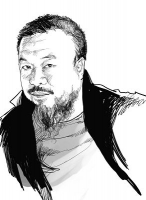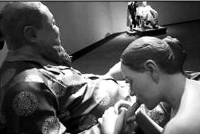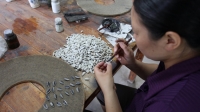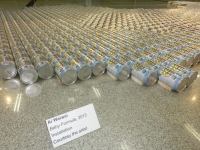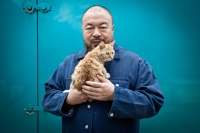| 籍貫: | 北京 | ||
閱讀艾未未 Ai Weiwei在百家争鸣的作品!!! | |||
AIWEIWEI 簡歷
1957年8月28日生於中國北京
1978年北京電影學院
1981年parsonsSchoolofDesign,ArtStudentleague,美國紐約。
1994-1999年主編出版前衛藝術刊物“黑皮書”(1994)、白皮書(1995)、灰皮書(1999)北京。
1998-1999年“中國藝術文件庫”藝術總監
展覽
1979年第一屆《星星畫展》,中國北京
1980年第二屆《星星畫展》,中國美術館,北京
1982年個展,舊金山亞洲基金會畫廊,美國。
1986年《七個中國藝術傢》VorpalGallery,美國
《中國新表現》紐約市市立畫廊,美國。
《中國前衛藝術》VassarCollegcGallery
AlbanyUniversityArtGallery,美國。
1987年《TheStaratHarvard》FairbankCenter,HarvardUniversity,美國。
1988年個展《舊鞋·性安全》美國紐約。
1989年《TheStar:TenYear》HanartGallery,香港,臺北,巴黎。
1990年國際版畫展,HanartGallery,臺北。
1994年《中國藝術展》東京畫廊,日本。
《中國當代藝術展》哥德堡藝術博物館,瑞典。
1995年《Configura2》,德國
1996年《彼得·路德維希收藏展》,德國。
1997年《交點》中、日、韓現代藝術展,韓國
1999年 第48屆威尼斯雙年展,意大利
2000年《伊西雙年展》,法國
1999年 《創新》,北京藝術文件倉庫,中國
《觀念和抽象》,北京藝術文件倉庫,中國
1999年 柯隆藝術節,德國
艾未未(1957年5月18日-),中國藝術傢,中國藝術文件倉庫藝術總監。同時活躍於建築、策展、攝影、電影,以及社會文化評論。艾未未是已故詩人艾青之子,他曾在美國居留與工作,於2008年北京奧運會擔任主要場地國傢體育場或稱“鳥巢”的設計藝術顧問。
艾未未除從事藝術創作,還關註維權活動,並對中國內地多個涉嫌政治腐敗而引發的事故進行調查,包括毒奶粉事件、汶川大地震中因政府興建學校偷工減料,而倒塌導致大量學生死亡事故、聲援被迫害的維權人士等。因其行動及言論曾受到政府的軟禁和暴力對待。
2011年4月3日,艾未未於北京被當局扣留,但超過法定期限一個多月仍未被起訴,中共透過傳媒指控艾未未涉嫌逃稅等多種不當行為, 後來公安機關聲稱查明艾未未涉嫌經濟犯罪。他被扣留事件觸發外界關註及部分人的聲援,有不少評論認為他被捕的原因是他參與維權活動及抨擊中共有關。 同年6月22日,艾未未獲當局取保候審,後來中國政府當局稱他漏稅,往後他仍周旋於被當局指控及監視之間。
早年生活
第十二屆文獻展展品,《模》
第十二屆文獻展展品,《客人的住處》艾未未1957年於北京出生,為已故中國現代詩人艾青與高瑛之子,其妻路青為畫傢,居於北京草場地村。中共發起的反右運動期間,艾青一傢於1958年被流放新疆並在新疆石河子居住了十六年,後於1975年全家返回北京。
1978年入讀北京電影學院,同期的學生包括中國導演陳凱歌與張藝謀。1981年至1993年艾未未主要居住在美紐約,並就讀紐約帕森設計學院,後因一門課未通過而被學校停止發放奬學金,最後更離開學校而成為非法居留者並以街頭畫像或打零工。他所混跡的紐約自身公寓,成為許多中國藝術傢在美國的中轉站,此外他亦同時成為一位積極的街頭抗議者,參與了許多街頭抗議活動,並多次與紐約警察發生肢體衝突,也曾拍下警察對別的抗議者實施過度暴力的照片。1987年在美國舉辦《舊鞋、性安全》藝術展,被藝評傢稱為“引人註目的新達達主義”。在1989六四事件中, 獲得“六四血卡”。但1993年4月父親艾青患病,他返回北京照顧父親並放棄了美國居民身分。
返回北京以後他協助成立北京東村,該地成為很多實驗藝術傢的傢園。他出版了一係列三本的書,名為《黑皮書》、《白皮書》和《灰皮書》。1999年艾未未在北京東北部的草場地建了自己的工作室和房子,這是他的第一個建築項目,他從這時候開始從事更多的建築項目並成立了名為發課工作室的建築事務所。
藝術生涯
早期1978年艾未未與馬德升、王剋平、黃銳、李爽、鐘阿城、麯磊磊等人創辦最終於1983年解散的星星畫會,艾未未至今仍有參與星星的集體美術展,例如1989年的《星星畫會十年展》與2007年的《原點:星星畫會回顧展》。1981年至1993年主要居住在美國紐約並曾就讀紐約帕森設計學院,這段時期深受杜尚顛覆正統風格的影響,製作的藝術品大多是以現成物件改裝的概念作品。他在1994年更為電視劇《北京人在紐約》擔任副導演。
展覽2000年時與馮博一在上海舉辦“不合作方式”藝術展。他的作品《童話》、《模》於2007年參加第十二屆卡塞爾文獻展,其中《模》被大雨摧毀,但艾未未沒有修復,並認為大自然的力量令作品更出色。在2010年艾未未被邀請創作一個作品來補充丹麥哥本哈根因租藉到上海參加世博會的美人魚雕像而造成的空位,他建造了一個能現場直播小美人魚世博會情況的閉路電視係統網站,來表達中國人都處在某種監視之下的真實生活。2010年9月19日,艾未未與左小祖咒參加了2010大聲展。
建築艾未未在建築設計上充滿了個人主義的風格,他在1999年設計及建造位於北京東五環外草場地村的艾未未工作室,2003年瑞士的建築事務所赫爾佐格和德梅隆(Herzog & de Meuron)設計北京國傢體育場“鳥巢”時他被聘為該項目的藝術顧問,還在2006年於紐約哈德遜河𠔌區設計一所私人住宅。2012年2月,倫敦肯辛頓公園(Kensington Gardens)宣佈,已邀得2008年北京奧運“鳥巢”的設計者、艾未未和兩名瑞士設計師再度攜手,設計奧運戶外場館,寓意延續北京奧運的精神。
著作1994年至1999年主編中國前衛藝術刊物《黑皮書》、《白皮書》、《灰皮書》。
譏諷之作艾未未藝術作品《一虎八奶圖》,被媒體解讀為譏諷中共而惹爭議。作品中的艾未未手巧妙地遮住下體,代表着“黨中央”(擋中央);雙手安穩地置於左膝上,表明堅定的左傾立場。畫面最左的女子,戴着眼鏡坐在沒有靠背的椅子,象徵知識分子有地位、有架子,但卻靠不住;而她撥弄頭髮,始終側身嚮着黨中央,也說明知識分子再怎麽賣弄,仍被政府牽着走。最右的女子體態豐腴,挂玉佩、戴手錶,是資産階級;她有地位也靠得住,雙手嚮身體右側擺,代表“右傾”立場。在這幅畫裏,黨中央與資産階級相隔甚遠,好比臺面上的關係,但兩人還有另外一張單獨合影,則象徵背後的官商勾結。畫中的短發女子原先沒有地位,僅能站着陪笑,但後來被黨中央拉去靠着坐,代表新聞媒體受控製。至於從頭到尾衹能站在椅後,身體被遮住最多的,則是沒有地位、也時常被無視的農工階級。中國作傢顧曉軍表示,該圖太真實和太大膽,真實得沒有任何一絲一縷的掩飾與編導痕跡,是大膽與其對藝術的詮釋。
維權之路
調查汶川大地震2008年5月汶川大地震發生後,大批校捨倒塌造成數千師生死亡,遇難學生傢長抨擊校捨可能存在建築問題,質疑當局為何在坍塌的校捨周圍其它建築物卻能夠經受地震的衝擊。 2008年5月,艾未未在其新浪的博客裏陸續公佈了2008年四川汶川大地震死亡的具體的學生名單,但這些數據不久後便被管理方刪除。
2008年12月5日艾未未發起了公民調查志願者活動,對512大地震遇難學生的具體數據,如;學校、姓名、年齡、班級、家庭住址、傢長聯繫方式等進行調查,截至2010年3月,公民調查共找到5212名遇難學生名單。2009年10月開始,艾未未以他發起的“公民調查”的名義嚮中央、四川省級、縣市級以及基金會等100多傢不同政府機構申請公開512條完整信息,包括災情核查、捐款使用明細、坍塌校捨調查報告、以及遇難師生具體情況等近萬條信息,但卻沒有得到任何正面回覆。
聲授維權人士2009年8月12日,艾未未與調查汶川大地震遇難學生校捨工程質量的志願者等人,應四川維權人士譚作人律師邀請而作為證人前往成都出庭。據稱當天凌晨在酒店遭到成都公安的拘禁及毆打,該過程被拍攝成紀錄片《老媽蹄花》並上傳至網絡。9月14日艾未未在德國慕尼黑美術館布展期間頭痛加劇被送到德國慕尼黑大學醫院,後經診斷為“腦出血”。 同年11月,艾未未的女助手從北京到日本東京成田國際機場探望並采訪因被上海當局拒絶返國而滯留於機場管製區內的維權人士馮正虎,並將過程剪輯成記錄片《馮正虎回傢》。2010年4月6日前往成都金牛區西安路派出所報案,要求警方對其在2009年8月12日被毆打事件立案偵查。5月4日,艾未未工作室完成紀錄片《美好生活》並上傳網絡。該片記錄了馮正虎回傢的故事。5月6日,發佈製作近兩年的楊佳案的全程紀錄片,《一個孤僻的人》及其續集《王靜梅》。5月12日,發佈紀念“512地震遇難學生”的《念》。
工作室突遭拆除2010年1月11日,艾未未在上海馬陸的藝術工作室遭到強拆,該根據上海嘉定區馬陸鎮的引進藝術傢規劃而興建的工作室,在建築完工不久,突然接獲馬陸鎮當局通知,稱其違反《城鄉規劃法》决定予以拆除。。艾未未在一個電話采訪中談到,強行拆除行為和政府之前的舉動完全不一致。他說:“他們不僅批準了這個工作室,甚至市長在一次針對這個地區發展的講話中,還用我做了宣傳”。負責興建工作室的呂恆中認為,強拆與艾未未追查造成6死5傷的楊佳襲警案有關。而據中央社報道,楊佳襲警案發生在2008年7月1日的上海市閘北區政法大樓,造成6死5傷事故。對此艾未未還特地發佈過講述楊佳案全部過程的記錄片“一個孤僻的人”,“希望人們不要遺忘”。
網絡評選被淡化2011年1月26日,新浪網在其收藏頻道推出“2010新浪藝術權力榜”評選活動,艾未未成為網友投票的第一名,但1月27日凌晨早上六時左右此評選頁面突然消失而被“2010年度藝術權力榜最具網絡人氣藝術機構評選”代替,2月16日, 在“2010年度藝術權力榜最具網絡人氣藝術機構評選”中,網友投票艾未未所設計的三影堂,令其得票數快速增長達到5000多票而位居榜首,然而到了當日晚間8點投票截止前,主辦方新浪網偷偷篡改投票數目,將原本嘉德的3400多票改為5000多票,而三影堂的5000多票改為4500多票,有網友電詢新浪,但新浪員工表示不知情也拒絶透露詳情。隨後在2月21日,於798藝術區品畫廊舉行的頒奬典禮中艾未未與助手到現場入口處抗議,還在牛博上發表了文章,過往2009年六四二十周年前夕,艾未未的新浪、搜狐和網易博客同時被徹底關閉,但艾未未在防火長城之外的牛博國際博客未受到影響。
參與遊行示威2010年2月22日,北京朝陽區金盞鄉長店村的創意正陽藝術區亦遭強製拆遷,有目擊者稱200多名身分不明的人到園區內打傷藝術傢、砸壞物品,包括日本藝術傢岩間賢在內的8人被打傷,並且有挖掘機毀壞房屋。艾未未當天下午與近20名藝術傢拉起寫着“公民權利”及“嚴懲兇手除黑打惡”的橫幅到北京長安街遊行示威,原來他們預定要走到天安門廣場,不過在距離廣場兩公裏處就被趕到的大批軍警和公安人員攔阻,第二天《環球時報》英文版罕有地對事件進行了報道,但報道該事件的記者文濤在20天後被開除。
被拘留往後之歷程2010年11月,艾未未的支持者數百人星期天聚集在其即將被強拆的上海工作室,參加“河蟹”宴,而艾未未本人仍被當局軟禁在北京傢中,無法成行。
2011年4月3日,艾未未原本計劃經由香港轉飛臺北,籌備10月在臺灣舉辦的一個展覽,但在北京上機前被邊檢人員帶走,公安並搜查了艾未未工作室,把八名工作人員帶至朝陽區南臯派出所問話。同時新浪微博上以“艾未未”為關鍵字搜索係統顯示“根據相關法律法規和政策,搜索結果未予顯示”,同時新浪屏蔽了有關艾未未被拘留的微博內容。
2011年4月11日路青告訴美聯社記者稱警方未告知她艾未未拘留地點、理由及時期,並於4月10日搜查了工作室,帶走了一些文檔、電腦和硬盤。
2011年5月16日,律師劉曉原會見了艾未未的母親高瑛及妻子路青,路青在5月15日在秘密關押地點見到了艾未未,並稱艾未未身體狀況良好,未被關在醫院或監獄,但沒有進一步說明艾未未的居住條件。路青猜測艾未未在外被監視居住。同一天,中國外交部副部長稱艾未未事件應信任中國司法。
2011年5月20日,《文匯報》援引新華社的消息稱“艾未未涉經濟犯罪查明”。 2011年5月21日,艾未未的姐姐高閣反駁了官方對他的偷漏稅指控。
2011年6月11日,艾未未被扣留第69天。艾未未的妻子路青及失蹤的發課文化發展有限公司的員工的傢屬再次聯名緻信公安部、北京市公安局、北京市檢察院、北京市紀委及北京市政法委。
2011年6月22日,中共官方媒體新華社報道北京市公安機關鑒於艾未未認罪態度好、患有慢性疾病等原因,且其多次主動表示願意積極補繳稅款,依法對艾未未取保候審。 艾未未對媒體表示“自己很開心回到傢裏,但由於仍在保釋階段,無法接受媒體采訪”。 英國皇傢國際事務研究所(Chatham House)的中國問題專傢羅德裏剋·維(Roderic Wye)認為中國政府釋放艾未未與中國總理溫傢寶訪問歐洲沒有聯繫。
2011年6月23日,艾未未表示,因為在取保候審期間,接下來一年內他不被允許離開北京,也不能接受采訪,不能上網。中國外交部發言人洪磊表示,針對艾未未的調查將繼續進行,艾未未不允許離開北京。 路青在接受美聯社電話采訪時表示當局不允許艾未未談及被拘禁和釋放的原因,且艾未未仍受到便衣警察監視跟蹤。
2011年6月24日,柏林德國外交政策協會的專傢桑德施奈德(Eberhard Sandschneider)認為,艾未未獲釋有可能是中國領導層面嚮最近訪問的東道主德國與英國所做出的和解姿態。
2011年6月28日,劉曉原律師透露當局要艾未未補交總數約200萬美元的稅款及罰款。艾未未本人拒絶對此事表態。
2011年7月15日,艾未未在接受自由亞洲電臺的采訪時,首次回應了中國政府當局稱他就偷漏稅案“認罪”的說法。他說:“我覺得認罪要建立在對我實行逮捕和起訴的程序上,然而這個程序從來沒有完成過,沒有真正的被逮捕或者起訴過,所以我覺得是一件很滑稽的事情。 " 談及偷稅案件時,他說:“所有關於稅務案的內容都是不清晰的,而且也不能進行公開的聽證,所以我覺得這方面是很明了的。”
2011年11月1日,艾未未收到北京市稅務局的罰款單,額度高達1500萬人民幣,限期15天補繳稅款。
2011年11月2日,艾未未的母親高瑛和弟弟艾丹以艾青故居為抵押物簽署抵押聲明。隨後有網友發起“成為艾未未債主”行動,表示要為艾未未藉款。
2011年11月7日,艾未未的支持者在網上發起借錢運動,協助艾未未度過難關,據艾未未說,網友通過各種方式“借錢”給他,其中包括郵政匯款、銀行轉賬等,甚至有人夜間隔着墻往他傢裏扔錢。艾未未承諾“每一分錢都還”。艾未未稱自己决不會用網友的錢繳稅,他將把這些錢放在一個公開安全的地方,以後有機會將全部退還。中共官方媒體《環球時報》當天發表社評稱“艾未未‘借錢還稅’搞得太戲劇性”。艾未未的母親高瑛譴責中共當局嚮艾未未追繳稅款。
2011年11月13日,截至當日,艾未未從支持者那裏獲得的“藉款”已經達到869萬元人民幣,但北京稅務部門拒絶接受艾未未依法繳納的保證金。
2011年11月18日,艾未未的罪名中除了稅務問題外,他以前與四名女性網友一起拍的一張裸體照片《一虎八奶圖》,被以“網上傳播淫穢照片”之名遭警方調查。
2012年03月29日,北京市地稅局稱,經復議决定艾未未上訴失敗,案件不舉行公開聽證,維持對原有的稅罰决定,罰款1,500萬元人民幣。艾未未在推特( Twitter)上指,“國傢說你偷漏稅你就偷漏稅了。中國的行政程序是為政治服務的,稅務成為公安維穩的工具”。
2012年4月3日,艾未未上年當天被拘捕,他在傢中安裝了四個攝像頭,24小時通過weiweicam.com網站對外直播他的生活,進行另類抗議,在官員要求下,艾未未的直播在歷時共47小時9分鐘後被迫關閉。艾獲釋後近一年仍然被監視居住,當局在他位於北京草場地的住所100米範圍內安裝超過15個閉路電視,禁止他離京。
中國政府及其媒體評論與爭議官方媒體
2011年4月6日凌晨,新華社英文版發表短信引述公安部門消息指“艾未未因為涉嫌經濟犯罪正依法接受調查”,不過報道很快就刪除,但香港親中共報章《文匯報》仍刊登了出來。中共官方報紙《人民日報》旗下的《環球時報》於4月6日發表社評“法律不會為特立獨行者彎麯”,於4月18日發表社評“西方給艾未未的庇護太特殊”。4月15日,香港《文匯報》發表文章“艾未未真面目:五玩藝術傢--五毒俱全”,指艾未未為藝術,玩政治,玩法律,玩感情,玩良知,文章對其行為詆毀。報道又指艾未未涉嫌逃漏稅、重婚罪和網絡散播淫穢物品罪被當局控製正在接受調查。5月12日,《環球時報》發表社評“汶川,千面中國的一個真實表情”,社評中稱“中國以涉嫌經濟犯罪逮捕艾未未,禁止街頭“茉莉花革命”,卻引起西方輿論的一片爭議”。 6月24日,《環球時報》發表社評“西方總想給中國法院‘批條子’”。
中國政府
2011年4月7日凌晨,中國官方新華社發佈簡短英文消息說,艾未未因為“涉嫌經濟犯罪” 正在接受警方調查,隨後,新華網對該消息進行刪除,但有網民對此消息進行截圖存證。隨後,中國外交部發言人洪磊也對此消息進行證實,稱被扣查的著名藝術傢艾未未涉嫌經濟犯罪案被調查。
爭議
香港時事評論員劉銳紹認為,官方新華社發表針對艾未未的文章是試圖抺黑他。如劉曉波等不同政見人士入罪前,都受到文章抺黑,這種亦是中國政府慣用的伎倆,他稱中國政府應讓艾未未有抗辯的機會。《人民日報》旗下的《環球時報》英文版,於2011年06月27日發表社論,指鬍佳、劉曉波、艾未未等人所以獲西方稱許,是緣於西方對中國政府的偏見,並非基於對中國社會及世界和平作出貢獻。文章又稱,艾未未等人均無一例外反對中國的政治體製,因此纔被西方稱許,並非因對中國社會及世界和平有所貢獻,最終會被西方社會遺忘
牽連
抄襲爭議
最先在香港上環街頭出現的“誰在害怕艾未未?”肖像塗鴉
香港藝術傢將艾未未頭像投射到警署大樓表達不滿
香港發起的1001張椅撐艾未未及被捕異見人士的行動2011年04月,在艾未未被捕後,新華社發表文章指其涉嫌經濟犯罪正接受調查,文章又指艾未未在德國展出的作品是抄襲藝術傢嶽路平的另作品。但嶽路平在新浪微博發表二千多字公開聲明,題目是“請新華社別濫用我的名字”。聲明指自己的名字被新華社招募成為一顆棋子,其本人並不情願。2011年4月17日,嶽路平在網志稱受到恐嚇,他又表示事情本是藝術界懸案,與政治無關,新華社如此渲染,對艾未未很不公平。
塗鴉抗議潮2011年4月13日,香港上環街頭出現多個白色漆油的艾未未肖像塗鴉,旁邊更有中英文字句寫道“誰在害怕艾未未?”,估計目的是抗議當局拘捕艾未未。警方把這個刑事毀壞案案件,交由專門調查嚴重罪行的重案組來處理,事件引起了香港部分人士質疑警方的政治中立性。有評論認為在香港隨處可見廣告塗鴉,但這次警方出動重案組調查,難逃政治打壓之嫌,衹會弄巧反拙。,而事件沒有平息,其後在多處位置出現同類塗鴉,有人甚至將艾未未的肖像投射到解放軍駐港部隊總部、灣仔警察總部等建築物的外墻及警車等渲泄。
外界評論及聲援2011年4月4日,身在悉尼的計算機人工智能博士後研究員阮吉建立了“我愛未未 i Love Weiwei”博客。
2011年4月23日,而在香港,超過一千名港人遊行要求中共當局釋放艾未未。
2011年5月2日,是艾未未被當局扣押一個月的日子。香港民主派號召民衆在維多利亞公園椅擺出一個巨大的“囚”字,象徵中國現在是世界上最大的囚牢,要求中國當局釋放艾未未以及包括劉曉波在內的所有政治異議人士。
2011年5月30日,在騰訊的QQ瀏覽器介紹網頁中出現“aiww”、“釋放”、“64”字樣(截圖),設計者用十分隱晦的方式抗議官方逮捕艾未未,隨後騰訊將網頁上的"#aiww#"改為了"#love#"。
2011年6月9日,艾未未部分專訪在瑞士日內瓦召開的聯合國人權理事會會議上首次公開。
2011年6月22日,香港新世紀出版社的負責人鮑樸認為艾未未突然被釋放可能和馬上到來的中國共産黨建黨90周年有關。
文藝界
2011年3月29日,由記者兼紀錄片製作者Alison Klayman拍攝的紀錄片《Who's afraid of Ai Weiwei?》(誰在害怕艾未未)在美國公共電視臺(PBS)Frontline播出。Alison Klayman於4月4日撰文“艾未未不是罪犯”
。
2011年4月3日,美國著名建築師Lebbeus Woods在自己的網志上聲明“不再接受中國的任何項目,直到艾未未被釋放”。
2011年5月15日,香港有藝術工作者繼早前的聲援艾未未遊行後,再次舉行遊行活動要求當局釋放艾未未和其他異見人士,高喊“釋放所有政治犯”等口號。
2011年5月28日,英國作傢Hari Kunzru撰文聲援艾未未。
2011年6月4日,中國流亡作傢貝嶺在中正紀念堂用1001張椅子排出“艾未未”三個大字。
2011年6月15日,著名的英國雕塑傢阿尼詩·卡普爾宣佈取消他原定在北京舉辦的展覽,以抗議中國政府關押艾未未。
2011年6月23日,著名的英國雕塑傢阿尼詩·卡普爾表示,艾未未獲假釋令他振奮,但是卡普爾並不相信艾未未逃稅。
政界
美國 2011年4月21日,駐華大使洪博培在時代雜志時代百大人物評選中為艾未未撰文。
中華民國 2011年4月6日,行政院陸委會主委賴幸媛在立法院表示艾未未此行訪臺目的單純而與政治活動無關,呼籲大陸方面立即釋放艾未未。2011年6月4日,中華民國總統馬英九發表六四事件紀念專文,並提到希望大陸當局早日釋放劉曉波、艾未未。
德國外長韋斯特韋勒、英國外交大臣威廉·黑格、法國外交部、美國國務院要求中共當局立即釋放艾未未。
國際組織
2011年4月4日,國際特赦組織亞太地區主任山姆·紮裏費(Sam Zarifi)指艾未未沒有參與任何“茉莉花”運動,他遭到拘捕似乎沒有任何理由。
2011年6月22日,國際特赦組織亞太地區副主任凱瑟琳·巴珀(Catherine Baber)認為中國政府釋放艾未未是為了轉移批評。同時國際特赦組織呼籲中國政府釋放艾未未工作室的其他四名被非法拘禁的助手文濤、鬍明芬、劉正剛和張勁鬆。
2011年6月23日,國際特赦組織再次要求中國政府表明艾未未工作室助手的下落。
2011年4月6日,人權觀察組織要求中國政府應立即釋放藝術傢、批評傢艾未未,並停止恣意打壓異議人士。
2011年6月22日,人權觀察組織亞洲倡導促進事務部主任,索菲·理查森 (Sophie Richardson)認為中國政府拘捕之後又釋放艾未未是出於政治目的,中國政府釋放艾未未也是國際輿論壓力起效果的一個例子。
榮譽2010年3月,艾未未於比利時根特大學的政治與社會學係獲得榮譽博士學位。9月獲頒德國卡塞爾市公民奬“理性棱鏡”奬;12月香港天文學會會長楊光宇成功嚮國際天文學會申請將小行星83598命名為艾未未星。同年英國《藝術評論》雜志把艾未未評為“現代藝術界最有影響力的100人”中的第十三名。
2011年6月,英國皇傢藝術學院授予艾未未為榮譽院士7月,德國柏林藝術大學授予艾未未教授職位。
2011年10月13日,艾未未被英國《藝術觀察》雜志評為全球最有影響力藝術人。
相關著作Ai Weiwei: Works Beijing 1993–2003
Ai Weiwei Speak
Ai Weiwei's Blog: Writings, Interviews, and Digital Rants, 2006-2009
Ai Weiwei
Art and Cultural Policy in China
Ai Weiwei / Herzog & De Meuron: Beijing, Venice, London
Becoming : Images of Beijings Air Terminal 3 by Ai Weiwei
生産模式,透視中國當代藝術(In Production Mode, Contemporary Art in China)
此時此地
Life and workAi Weiwei's father was Chinese poet Ai Qing, who was denounced during the Anti-Rightist Movement and in 1958 sent to a labour camp in Xinjiang with his wife, Gao Ying. Ai Weiwei was one year old at the time and lived in Shihezi for 16 years. In 1975 the family returned to Beijing. Ai Weiwei is married to artist Lu Qing.
In 1978, Ai enrolled in the Beijing Film Academy and attended school with Chinese directors Chen Kaige and Zhang Yimou. In 1978, he was one of the founders of the early avant garde art group the "Stars", together with Ma Desheng, Wang Keping, Huang Rui, Li Shuang, Zhong Acheng and Qu Leilei. The group disbanded in 1983, yet Ai participated in regular Stars group shows, The Stars: Ten Years, 1989 (Hanart Gallery, Hong-Hong and Taipei), and a retrospective exhibition in Beijing in 2007:Origin Point (Today Art Museum, Beijing).
From 1981 to 1993, he lived in the United States, mostly in New York, creating conceptual art by altering readymade objects. He studied at Parsons School of Design and at the Art Students League of New York. At the same time, Ai became fascinated by blackjack card games and frequented Atlantic City casinos. He is still regarded in gambling circles as a top tier professional blackjack player according to an article published on blackjackchamp.com.
In 1993, Ai returned to China after his father became ill. He helped establish the experimental artists' Beijing East Village and published a series of three books about this new generation of artists: Black Cover Book (1994), White Cover Book (1995), and Gray Cover Book (1997).
Ai Weiwei's contribution to the Documenta 12 in Kassel 2007Ai Weiwei is its Artistic Director of China Art Archives & Warehouse (CAAW), which he co-founded in 1997. This contemporary art archive and experimental gallery in Beijing concentrated on experimental art from the People's Republic of China, initiates and facilitates exhibitions and other forms of introductions inside and outside China. The building which houses it was designed by Ai in 2000.
In 1998, Ai moved to Caochangdi, in the northeast of Beijing, and built a studio house – his first architectural project. Due to his interest in architecture, he founded the architecture studio FAKE Design, in 2003. In 2000, he co-curated the art exhibition Fuck Off with curator Feng Boyi in Shanghai, China.
In 2006, Ai and HHF Architects designed a private residence in upstate New York for collectors Christopher Tsai and André Stockamp. According to the New York Times, the Tsai Residence is divided into four modules and the details are "extraordinarily refined". In 2009, the Chicago Athenaeum Museum of Architecture and Design selected the home for its International Architecture Awards, one of the world's most prestigious global awards for new architecture, landscape architecture, interiors and urban planning. In 2010, Wallpaper magazine nominated the Tsai Residence for its Wallpaper Design Awards category: Best New Private House. A detached guesthouse to the Tsai Residence, also designed by Ai and HHF Architects, was completed after the main house and, according to New York Magazine, looks like a "floating boomerang of rusty Cor-Ten steel."
Ai Weiwei's Fountain of Light (2007) is a 7m high tower of steel and crystals, reinterpreting Vladimir Tatlin's Monument to the Third International.
On 15 March 2010, Ai took part in Digital Activism in China, a discussion hosted by The Paley Media Center in New York with Jack Dorsey (founder of Twitter) and Richard MacManus.
ExhibitionsAi's artwork has been exhibited in Australia, Europe, North and South America. Solo exhibitions include Stiftung DKM, Duisburg (2010); Museum of Contemporary Craft, Portland (2010); Arcadia University Gallery, Glenside (2010); Mori Art Museum, Tokyo (2009); Haus der Kunst, Munich (2009); Three Shadows Photography Art Center, Beijing (2009); Sherman Contemporary Art Foundation, Cambelltown Arts Center, Sydney (2008); Groninger Museum, Groningen (2008).
Ai’s work was included in the 48th Venice Biennale in Italy (1999), 1st Guangzhou Triennale in China (2002), 1st Montpellier Biennial of Chinese Contemporary Art in France (2005), The 2nd Guangzhou Triennial (2005), Busan Biennial in Korea (2006), The 5th Asia-Pacific Triennial of Contemporary Art in Australia (2006), Documenta 12 in Germany (2007), Liverpool Biennial International 08 in the United Kingdom (2008), 2010 Venice Architecture Biennale and the 29th Sao Paulo Biennial in Brazil (2010).
Sunflower Seeds, 2010Fairytale is the title of Ai's contribution for Documenta 12 in 2007. For this project Ai brought 1001 people from all over China to the city of Kassel in Germany. They were chosen through an open invitation he posted on his blog. Ai even designed clothes, luggage and a temporary home in an old textile factory. He let them wander around the city during the exhibition time of three months. The participants were divided into five groups that each stayed in Kassel for eight days. According to Philip Tinari the primary design object here is not the clothing or suitcases but the participants' experiences, even their spirits. During the exhibition his monumental outdoor sculpture titled Template, made of wooden doors and windows from destroyed Ming and Qing Dynasty houses (1368–1911), collapsed after a storm. In 2008 he curated the architecture project Ordos 100 in Ordos City, Inner Mongolia. He invited 100 architects from all over the world (29 countries) to participate in this project.
Ai curated the exhibition The State of Things, together with Belgian artist Luc Tuymans. It was shown at the Centre for Fine Arts in Brussels from 18 October 2009 to 10 January 2010 and at the National Art Museum in Beijing from 1–30 May 2010. From October 2009 to January 2010 Ai exhibited So Sorry at Haus der Kunst in Munich, Germany. This solo exhibition showed Ai’s largest retrospective to date. The title refers to the thousands of apologies expressed recently by governments, industries, and financial corporations worldwide in an effort to make up for tragedies and wrongdoings – though often withhout shouldering the consequences or the desire to acknowledge let alone repair. Saying sorry – or not saying it – is in the headlines everywhere and thus also in China. For this show Ai created the installation Remembering on Haus der Kunst's façade. It was made out of 9000 children's backpacks. They spell out the sentence 'She lived happily for seven years in this world' in Chinese characters. This is a quote from a mother whose child died in the Sichuan earthquake in 2008. Ai said: "The idea to use backpacks came from my visit to Sichuan after the earthquake in May 2008. During the earthquake many schools collapsed. Thousands of young students lost their lives, and you could see bags and study material everywhere. Then you realize individual life, media, and the lives of the students are serving very different purposes. The lives of the students disappeared within the state propaganda, and very soon everybody will forget everything."
Template (2007) after collapseOn 25 July 2009 Ai opened his solo show According to What? at Tokyo's Mori Art Museum, Japan. This exhibition presented 26 works, most made over the past decade.
In December 2009, Ai had a small exhibition at the Comme des Garcons store in Hong Kong.
In February 2010, Ai Weiwei: Dropping the Urn, the first exhibition by Ai to travel outside New York City in the United States, opened at Arcadia University Art Gallery. The exhibition traveled to the Museum of Contemporary Craft in 2010, and the Knoxville Museum of Art and the Victoria and Albert Museum, London, in 2011. Included in the exhibition were iconic works by Ai including a Chinese figure in a Johnnie Walker liquor bottle (Untitled, 1993) and a Coca-Cola vase (Coca-Cola vase, 1997) from the collection of Christopher Tsai and André Stockamp.
From March to September 2010, Ai exhibited Barely Something, an exhibition curated by Roger M. Buergel, the director of Documenta12, at the Museum DKM in Duisburg, Germany.
In October 2010, Sunflower Seeds was installed at the Tate Modern Turbine Hall, London. The work consists of one hundred million porcelain "seeds," each individually hand-painted in the town of Jingdezhen by 1,600 Chinese artisans, and scattered over a large area of the exhibition hall. The artist was keen for visitors to walk across and roll in the work to experience and contemplate the essence of his comment on mass consumption, Chinese industry, famine and collective work. However, on 16 October, Tate Modern stopped people from walking on the exhibit due to health liability concerns over the porcelain dust. In February 2011, a 220-pound (100 kg) pile from Sunflower Seeds sold for $559,394 (well above its high estimate of $195,000) at Sotheby's in London.
Despite the artist's absence, Circle of Animals/Zodiac Heads opened on 4 May 2011, at the Pulitzer Fountain outside the Plaza Hotel in New York City. The heads were also on display at Somerset House in London from 12 May – 26 June 2011. The heads copy 18th century heads in the gardens of the Old Summer Palace, or Yuanmingyuan, near Beijing. They were ransacked by British and French troops during the Second Opium War of 1860, some of them resurfacing in 2000. A Guggenheim curator read Ai's words, "Without freedom of speech there is no modern world, just a barbaric one."
Ai's work is included in numerous public collections, among others the Los Angeles County Museum of Art, and the Museum of Contemporary Art, San Diego. On 20 April 2011, Ai was appointed Visiting Professor of the Berlin University of the Arts.
For the first time outside of China, his photographs of his time in New York City from 1983 to 1993 are featured in an exhibition presented by Asia Society. The earliest photographs are from 1983, while he was living in the Williamsburg neighborhood of Brooklyn. In 1985, he moved to Manhattan’s Lower East Side, where he lived in two different apartments until he returned to China in 1993 to be with his ailing father. The exhibition includes images of the poets Allen Ginsberg, Gu Cheng, and Bei Dao. The exhibition, showcasing 227 photos, opened on 29 June and lasted until 14 August 2011; It then took place at Martin Gropius Bau in Berlin from 15 October 2011 to 18 March 2012. Another exhibition this year Ai Weiwei: Dropping the Urn at the Victoria and Albert Museum from 15 October 2011 – 18 March 2012 featured a selection of ceramic works including Coca Cola Vase and a pile of sunflower seeds. In his ceramic works Ai angages with issues as the loss of historic material culture due to rapid modernization as well as broader themes including perceptions of value, mass production, globalization and the concepts of 'real' and 'fake'.
Awards and NominationsIn March 2010, Ai received an Honorary Doctorate Degree from the Faculty of Politics and Social Science, University of Ghent, Belgium.
In September 2010 he received Das Glas der Vernunft (The Prism of Reason), Kassel Citizen Award, Kassel, Germany.
Ai was ranked 13th in ArtReview's guide to the 100 most powerful figures in contemporary art: Power 100, 2010. Ai is now on top of ArtReview's guide to the 100 most powerful figures in contemporary art: Power 100, 2011.
In December 2011, he was one of four runners-up in Time's Person of the Year award.
Beijing National Stadium
The Beijing National Stadium at night during the 2008 Summer OlympicsAi was commissioned as the artistic consultant for design, collaborating with the Swiss firm Herzog & de Meuron, for the Beijing National Stadium for the 2008 Summer Olympics, also known as the "Bird's Nest." Although ignored by the Chinese media, he had voiced his anti-Olympics views. He later distanced himself from the project, saying, "I've already forgotten about it. I turn down all the demands to have photographs with it," saying it is part of a "pretend smile" of bad taste. In August 2007 he also accused those choreographing the Olympic opening ceremony, including Steven Spielberg and Zhang Yimou, of failing to live up to their responsibility as artists. Ai said "It's disgusting. I don't like anyone who shamelessly abuses their profession, who makes no moral judgment." In February 2008, Spielberg withdrew from his role as advisor to the 2008 Summer Olympics. When asked why he participated in the designing of the Bird's Nest in the first place, Ai replied "I did it because I love design."
Sichuan earthquake student casualties investigationOn 15 December 2008, Ai supported an investigation, started by another Chinese artist, into student casualties in the 2008 Sichuan earthquake. The investigation aimed to compile a list of students killed in the earthquake by 12 May 2009, the earthquake's first anniversary. As of 14 April 2009, the list had accumulated 5,385 names. Ai published the collected names as well as numerous articles documenting the investigation on his blog which was shut down by Chinese authorities in May 2009. He also posted his list of names of schoolchildren who died on the wall of his office at FAKE Design in Beijing.
Ai suffered headaches and claimed he had difficulty concentrating on his work since returning from Chengdu in August 2009, where he was beaten by the police for trying to testify for Tan Zuoren, a fellow investigator of the shoddy construction and student casualties in the earthquake.
On 14 September 2009, Ai was diagnosed to be suffering internal bleeding in a hospital in Munich, Germany, and the doctor arranged for emergency brain surgery. The cerebral hemorrhage is believed to be linked to the police attack.
According to the Financial Times, in an attempt to force Ai to leave the country, two accounts used by him had been hacked in a sophisticated attack on Google in China dubbed Operation Aurora, their contents read and copied; his bank accounts were investigated by state security agents who claimed he was under investigation for "unspecified suspected crimes".
Shanghai studio controversyIn November 2010, Ai was placed under house arrest by the Chinese police. He said this was to prevent the planned party marking the demolition of his newly built Shanghai studio.
The building was designed and built by Ai upon encouragement and persuasion from a "high official [from Shanghai]" as part of a new cultural area designated by Shanghai Municipal authorities; Ai would have used it as a studio and to teach architecture courses. But now Ai has been accused of erecting the structure without the necessary planning permission and a demolition notice has been ordered, even though, Ai said, officials had been extremely enthusiastic, and the entire application and planning process was "under government supervision". According to Ai, a number of artists were invited to build new studios in this area of Shanghai because officials wanted to create a cultural area.
On 3 November 2010 Ai said the government had informed him two months earlier that the newly completed studio would be knocked down because it was illegal. Ai complained that this was unfair, as he was "the only one singled out to have my studio destroyed." The Guardian reported Ai saying Shanghai municipal authorities were 'frustrated' by documentaries on subjects they considered sensitive: two of the better known ones featured Shanghai resident Feng Zhenghu, who lived in forced exile for three months in Narita Airport, Tokyo; another well known documentary focused on Yang Jia, who murdered six Shanghai police officers.
In the end, the party took place without Weiwei's presence; his supporters feasted on river crab, an allusion to "harmony", and a euphemism used to jeer official censorship. Ai was released from house arrest the next day.
Like other activists and intellectuals, Ai was prevented from leaving China in late 2010. Ai suggested that the authorities wanted to prevent him from attending the ceremony in December 2010 to award the 2010 Nobel Peace Prize to fellow dissident Liu Xiaobo. Ai said that he had not been invited to the ceremony, and was attempting to travel to South Korea for a meeting when he was told that he could not leave for reasons of national security.
In the evening of 11 January 2011, Ai's studio was demolished in a surprise move by the local government.
2011 arrest
South China Morning Post reports that Ai received at least two visits from the police, the last being on 31 March – three days before his detention – apparently with offers of membership to the Chinese People's Political Consultative Conference. A staff member recalled that Ai had mentioned receiving the offer earlier, "[but Ai] didn't say if it was a membership of the CPPCC at the municipal or national level, how he responded or whether he accepted it or not."
On 24 February, amid an online campaign for Middle East-style protests in major Chinese cities by overseas dissidents, Ai posted on his Twitter account: "I didn’t care about jasmine at first, but people who are scared by jasmine sent out information about how harmful jasmine is often, which makes me realize that jasmine is what scares them the most. What a jasmine!"
The caption (草泥马挡中央, "grass mud horse covering the middle") to Ai's self-portrait sounds almost the same in Chinese as 肏你妈党中央, "Fuck your mother, the Communist party central committee".On 3 April, Ai was arrested at Beijing Airport just before catching a flight to Hong Kong and his studio facilities were searched. A police contingent of approximately 50 officers came to his studio, threw a cordon around it and searched the premises. They took away laptops and the hard drive from the main computer; along with Ai, police also detained eight staff members and Ai's wife, Lu Qing. Police also visited the mother of Ai's two year-old son. While state media originally reported on 6 April that Ai was arrested at the airport because "his departure procedures were incomplete," the Chinese Ministry of Foreign Affairs said on 7 April that Ai was arrested under investigation for alleged economic crimes. Then, on 8 April, police returned to Ai's workshop to examine his financial affairs. On 9 April, Ai's accountant, as well as studio partner Liu Zhenggang and driver Zhang Jingsong, disappeared, while Ai's assistant Wen Tao has remained missing since Ai's arrest on 3 April. Ai's wife said that she was summoned by the Beijing Chaoyang district tax bureau, where she was interrogated about his studio's tax on 12 April.
Response to Ai's arrestSee also: Free Ai Weiwei street art campaign
Analysts and other activists said Ai had been widely thought to be untouchable, but Nicholas Bequelin from Human Rights Watch suggested that his arrest, calculated to send the message that no one would be immune, must have had the approval of someone in the top leadership. International governments, human rights groups and art institutions, among others, have called for Ai's release, while Chinese officials have yet to notify Ai's family of his whereabouts.
State media started describing Wei as a 'deviant and a plagiarist' in early 2011. The China Daily subsidiary, the Global Times editorial on 6 April 2011 attacked Wei, saying "Ai Weiwei likes to do something 'others dare not do.' He has been close to the red line of Chinese law. Objectively speaking, Chinese society does not have much experience in dealing with such persons. However, as long as Ai Weiwei continuously marches forward, he will inevitably touch the red line one day." Two days later, the journal scorned Western media for questioning Ai's charge as a "catch-all crime", and denounced the use of his political activism as a "legal shield" against everyday crimes. It said "Ai's detention is one of the many judicial cases handled in China every day. It is pure fantasy to conclude that Ai's case will be handled specially and unfairly." Frank Ching expressed in the South China Morning Post that how the Global Times could radically shift its position from one day to the next was reminiscent of Alice in Wonderland.
Tate Modern in London, home to Ai's 'Sunflower Seeds' exhibition, put a large sign on their exterior that reads "Release Ai Weiwei"Michael Sheridan of The Times suggested that Ai had offered himself to the authorities on a platter with some of his provocative art, particularly photographs of himself nude with only a toy alpaca hiding his modesty – with a caption『草泥马挡中央』 ("grass mud horse covering the middle"). The term possesses a double meaning in Chinese: one possible interpretation was given by Sheridan as: "Fuck your mother, the party central committee".
Ming Pao in Hong Kong reacted strongly to the state media's character attack on Ai, saying that authorities had employed “a chain of actions outside the law, doing further damage to an already weak system of laws, and to the overall image of the country.” Pro-Beijing newspaper in Hong Kong, Wen Wei Po, announced that Ai was under arrest for tax evasion, bigamy and spreading indecent images on the internet, and vilified him with multiple instances of strong rhetoric. Supporters said "the article should be seen as a mainland media commentary attacking Ai, rather than as an accurate account of the investigation."
The United States and European Union protested Ai's detention. The international arts community also mobilised petitions calling for the release of Ai: "1001 Chairs for Ai Weiwei" was organized by Creative Time of New York that calls for artists to bring chairs to Chinese embassies and consulates around the world on 17 April 2011, at 1 pm local time "to sit peacefully in support of the artist's immediate release." Artists in Hong Kong, Germany and Taiwan demonstrated and called for Ai to be released.
One of the major protests by U.S. museums took place on 19 and 20 May when the Museum of Contemporary Art San Diego organized a 24-hour silent protest in which volunteer participants, including community members, media, and museum staff, occupied two traditionally styled Chinese chairs for one-hour periods. The 24-hour sit-in referenced Ai’s sculpture series, Marble Chair, two of which were on view and were subsequently acquired for the Museum’s permanent collection.
The Solomon R. Guggenheim Foundation and the International Council of Museums, which organised petitions, said they had collected more than 90,000 signatures calling for the release of Ai. On 13 April 2011, a group of European intellectuals led by Václav Havel had issued an open letter to Wen Jiabao, condemning the arrest and demanding the immediate release of Ai. The signatories include Ivan Klíma, Jiří Gruša, Jáchym Topol, Elfriede Jelinek, Adam Michnik, Adam Zagajewski, Helmuth Frauendorfer; Bei Ling (Chinese:贝岭), a Chinese poet in exile drafted and also signed the open letter.
On 16 May 2011, the Chinese authorities allowed his wife to visit him briefly. Liu Xiaoyuan, his attorney and personal friend, reported that Wei was in good physical condition and receiving treatment for his chronic diabetes and hypertension; he was not in a prison or hospital but under some form of house arrest.
He is the subject of the 2012 documentary film Ai Weiwei: Never Sorry, directed by American filmmaker Alison Klayman, which received a special jury prize at the 2012 Sundance Film Festival and will open the Hot Docs Canadian International Documentary Festival, North America’s largest documentary festival, in Toronto on April 26, 2012.
ReleaseOn 22 June 2011, the Chinese authorities released Ai on bail after close to three months' detention on charges of tax evasion. Beijing Fake Cultural Development Ltd., a company Ai controlled, had allegedly evaded taxes and intentionally destroyed accounting documents. State media also reports that Ai was granted bail takes on account of Ai's "good attitude in confessing his crimes", willingness to pay back taxes, and his chronic illnesses. According to the Chinese Foreign Ministry, he is prohibited from leaving Beijing without permission for one year.
Ai's supporters widely viewed his detention as retaliation for his vocal criticism of the government. On 23 June 2011, professor Wang Yujin of China University of Political Science and Law stated that the release of Ai on bail shows that the Chinese government could not find any solid evidence of Ai's alleged "economic crime".
On 24 June 2011, Ai told a Radio Free Asia reporter that he was thankful for the support of the Hong Kong public, and praised Hong Kong's conscious society. Ai also mentioned that his detention by the Chinese regime was hellish (Chinese: 九死一生), and stressed that he is forbidden to say too much to reporters.
After his release, his sister gave some details about his detention condition to the press, explaining that he was subjected to a kind of psychological torture: he was detained in a tiny room with constant light, and two guards were set very close to him at all times, and watched him constantly.
In November, Chinese authorities were again investigating Ai and his associates, this time under the charge of spreading pornography. Lu was subsequently questioned by police, and released after several hours though the exact charges remain unclear.
Unpaid taxes and finesIn June 2011, the Beijing Local Taxation Bureau demanded a total of over 12 million yuan (US $1.85 million) from Beijing Fake Cultural Development Ltd in unpaid taxes and fines, and accorded three days to appeal the demand in writing. According to Ai's wife, Beijing Fake Cultural Development Ltd has hired two Beijing lawyers as defense attorneys. Ai's family state that Ai is neither the chief executive nor the legal representative of the design company, which is registered in his wife’s name." Lawyer-friend Liu Xiaoyuan has initiated an internet donation (or 'loan') campaign to help Ai to pay the unpaid taxes. They have reportedly received 1 million yuan.
Lawyers acting for Ai submitted an appeal against the fine in January 2012; the Chinese government subsequently agreed to conduct a review.
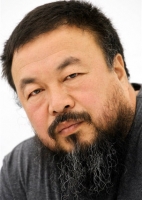
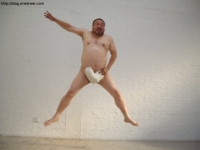
![回顧] 艾未未最近作品 [回顧] 艾未未最近作品
點擊圖片查看詳情](http://oson.ca/upload/images11/cache/c9cb0022ed0fc24534cb8c7b2ebafba0.jpg)

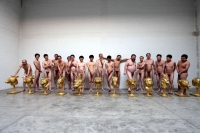
![藝術看客]藝術是個意外評艾未未的
點擊圖片查看詳情](http://oson.ca/upload/images11/cache/bf8b3cec1ab38acd768f6d589291df5e.jpg)
